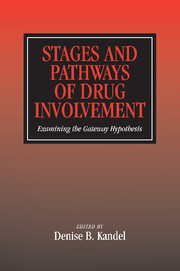Book contents
- Frontmatter
- Contents
- List of Contributors
- Foreword
- Preface
- Part I Overview
- Part II Recent Substantive Findings: What Do We Know About Stages of Drug Use, Risks, and Protective Factors?
- Part III Impact of Prevention Interventions: A Test of the Progression Hypothesis
- Part IV Methodological Issues and Approaches: Advantages and Limitations of Alternate Methods
- Part V Animal Models and Biological Processes: Implications for Drug Progression
- Part VI Conclusion
- Index
Preface
Published online by Cambridge University Press: 25 July 2009
- Frontmatter
- Contents
- List of Contributors
- Foreword
- Preface
- Part I Overview
- Part II Recent Substantive Findings: What Do We Know About Stages of Drug Use, Risks, and Protective Factors?
- Part III Impact of Prevention Interventions: A Test of the Progression Hypothesis
- Part IV Methodological Issues and Approaches: Advantages and Limitations of Alternate Methods
- Part V Animal Models and Biological Processes: Implications for Drug Progression
- Part VI Conclusion
- Index
Summary
The notion that use of certain drugs is a precursor to the use of other drugs was first proposed in the 1970s. The notion derived from the empirical observation that young people progressed from the use of legal drugs, such as tobacco or alcohol, to the use of illicit drugs, such as marijuana, cocaine, and heroin. In the 1980s, the term Gateway drug was introduced and it was emphasized that certain drugs serve as gateways for other substances. Because of the theoretical and public policy implications of the Gateway Hypothesis for understanding the progression of adolescent drug use and for formulating prevention and intervention programs, a conference was organized to examine the hypothesis critically. That conference, Stages and Pathways of Drug Involvement: Examining the Gateway Hypothesis, was held in Los Angeles on June 27–30, 1998. This book derives from the conference.
To evaluate current thinking and the strengths and weaknesses of various aspects of the Gateway Hypothesis, a multidisciplinary group of scientists was brought together, representing the disciplines of sociology, psychology, epidemiology, statistics, animal behavior, molecular biology, and prevention. In addition to the authors of the chapters in this volume, several senior scholars attended the conference: Lee Robins of Washington University in St. Louis, Klaus Hurrelmann of the University of Bielefeld of the federal Republic of Germany, David Huizinga of the Institute of Behavioral Research of the University of Colorado, Charles O'Brien of the University of pennsylvania, James D. Colliver and Lucinda L. Miner of the National Institute on Drug Abuse, Vivian Faden of the National Institute on Alcohol Abuse and Alcoholism, and Herbert Simpson of the Traffic Injury Research Foundation.
- Type
- Chapter
- Information
- Stages and Pathways of Drug InvolvementExamining the Gateway Hypothesis, pp. xv - xviPublisher: Cambridge University PressPrint publication year: 2002

